Moths - Order Lepidoptera
This page contains pictures and information about Moths and Caterpillars that we found in the Brisbane area, Queensland, Australia.

- Looper Moth, wingspan 50mm
Butterflies and Moths are closely related insects which are classified together as an Order Lepidoptera, meaning 'scaly wings'. The colour of the butterflies and moths are formed by the scales which cover the wings. Those scales will come off easily and this is considered as an evolved weapon against the Spider's web. Another feature of butterflies and moths are their mouths, or their proboscis, that curl up under the heads. Their proboscis can be extended and inserted into the flowers to suck up liquid food.
Most butterflies are colourful and fly by day while most moths are dull in colour and active at night. However there are some exceptions, a few species of moths are day flying and as colourful as butterflies. The major different between butterflies and moths are when at rest, most butterflies hold their wings upright over their back while the moths usually hold their wings open and flat. Their antennae are also different. Most butterflies have their antennae smooth and straight, with a 'club' at the end. Moths have their antennae without club and some are feather like.
- Moths are much more diverse than butterflies in Brisbane and in the world. Most of them we found are not yet identified. Adults moths body size are range from 3mm to 60mm. The larva is caterpillar, with a head and soft thorax and usually 10- segmented abdomen. They are complete metamorphosis. The adults are usually feed on nectar and pollen, while most caterpillars feed on plants leave, but some are feed on wood or roots.
Classification :
Superfamily TINEOIDEA
 Family Psychidae
- Case Moths
Family Psychidae
- Case Moths - Most species the caterpillars live in a mobile case. The case is made of silk and plants materials. Each species make case in different shapes. For some species, if it is a female, it will not develop wings and will never come out of the bag. It just wait for a winged male in her bag.
-
 Family Gracillariidae - Leaf Miners
Family Gracillariidae - Leaf Miners - The caterpillars in this family form tunnels and cavities in the spongy layer between the upper and lower surfaces of leaves. Their adult moths are slander and small in size. Their wings are narrows, with long hair along the hind wing margins.
Superfamily GELECHIOIDEA
-
 Family Oecophoridae - Concealer Moths
Family Oecophoridae - Concealer Moths - In this family the caterpillar habits are diverse, but most are feed on Eucalyptus, include live or dead materials. We only found one species in this family.

 Family
Tortricidae - Leafrollers, Bell Moths
Family
Tortricidae - Leafrollers, Bell Moths - Some member of this family are called Leafrollers because their caterpillars roll the leaves of their foodplant. They are sometimes called Bell Moths because their adults have the shape of church bell.
 Family Castniidae - Sun Moths
Family Castniidae - Sun Moths- They fly during the day and have clubbed antenna, but they are not butterflies. They are Sun Moths. A family of moths that active during the day. They usually have brown forewings but bright colour hind wings. Their caterpillars are hardly be seen for they tunnel in soil.

 Family
Limacodidae - Cup Moths
Family
Limacodidae - Cup Moths- They are named 'Cup Moths' because the shape of their pupal cocoon look like a cup. Most caterpillars have their stinging hairs when disturbed, and they usually have the bright warning colours. Adults have fat and furry bodies, from small to medium size.
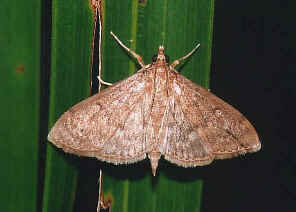 Family Pyralidae,
Crambidae -
Pyralid Moths
Family Pyralidae,
Crambidae -
Pyralid Moths- Family PYRALIDAE was recently split into CRAMBIDAE and PYRALIDAE. In general, moths in this two families rest with wings in triangular shape. They are small in size and have relatively long legs.
Superfamily TORTRICOIDEA
Superfamily CASTNIOIDEA
Superfamily ZYGAENOIDEA
Superfamily PYRALOIDEA
Superfamily GEOMETROIDEA

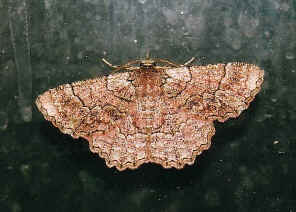 Family Geometridae -
Looper
Family Geometridae -
Looper - Most Caterpillars in this family only have one or two pair of prolegs. They move with curving their bodies into loops and usually hairless and with slender body. The moths have camouflaged wing patterns of wavy lines extend across both fore and hind wings.
Superfamily BOMBYCOIDEA

 Family Lasiocampidae - Snout Moths
Family Lasiocampidae - Snout Moths- The Caterpillars of this family are medium to large size. Most have a pair of dorsal glands on abdomen. Many have flaps of skin overhanging their prolegs and they like to lie along twigs. The adult moths are large and stout, have elongated mouth parts.

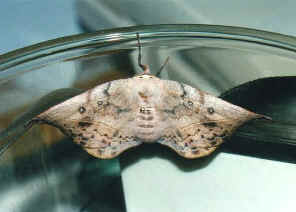 Family Anthelidae -
Anthelid Moths
Family Anthelidae -
Anthelid Moths- The Caterpillars are from medium to very large size. They are very hairy. Their heads are large, and usually have the wearing sunglass look. ANTHELIDAE moths fly at night. They have stout hairy body and board wings.

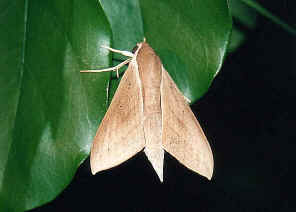 Family Sphingidae -
Hawk
Moths
Family Sphingidae -
Hawk
Moths - Hawk Moths are large size moths. They have the strong and aerodynamic -shaped body. Their forewings are narrow and long with smaller hind wings. They are very good flyer. When at rest, they hold their wings on body like a tent.
Superfamily SPHIGOIDEA
Superfamily NOCTUOIDEA

 Family
Notodontidae - Processionary Caterpillars
Family
Notodontidae - Processionary Caterpillars- Most Caterpillars of NOTODONTIDAE will raise their head and/or tail when disturbed. Some of them are hairy but some are smooth with few spines. They are usually colourful and active during the day.
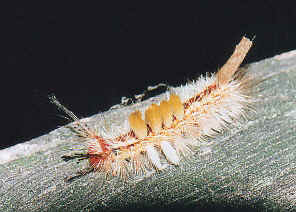
 Family Lymantriidae -
Tussock Moths
Family Lymantriidae -
Tussock Moths- Their Caterpillars are also hairy, often with four distinct tussocks of hair on their back make them look like a toothbrush. Moths in this family are small to medium size with hairy body. They held their board wings like roots over their abdomen at rest.

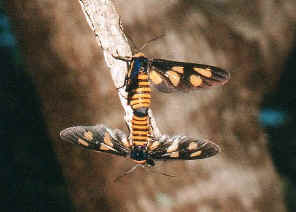 Family Arctiidae - Tiger Moths
Family Arctiidae - Tiger Moths- Most Caterpillars of the ARCTIIDAE are covered in dense dark hairs. The caterpillars are small to medium size. The adults usually have bright warning colour patterns, which are spotted in red, orange, black or white. Their abdomen usually striped with black and yellow-red colour.

 Family Aganaidae - Tiger
Moths
Family Aganaidae - Tiger
Moths- This family is very closely related with family Arctiidae and sometimes put as its sub-family.
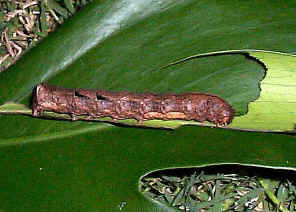
 Family Noctuidae -
Armyworms and Semi-Loppers
Family Noctuidae -
Armyworms and Semi-Loppers- Their Caterpillars are usually smooth or with little hairs. They are from small to large size. The adults mainly fly at night. They usually feed on nectar from flowers or ripe fruit. Most are dull in colour, but some have colourful hindwings.
- Unknown Moths and Unknown Caterpillars
- There are some Unknown Moths and Unknown Caterpillars that yet to be identified. Please advise if you can identify any of them.
- Here we would like to thank Don Herbison-Evans for his kindly advices on the identity of some caterpillars and adults in our web site. His Australian Caterpillars web site is our major reference.
[ Case Moths ] [ Leaf Miners ] [ Leaf Rollers ] [ Concealer Moths ] [ Sun Moths ] [ Pyralid Moths ] [ Snout Moths ] [ Anthelid Moths ] [ Hawk Moths ] [ Unknown Moths ] [ Unknown Caterpillars ] - Back to Top
